70s Sci Fi Art Book About Living in the Future

Art by: ANTIFAN-REAL @ deviantART
Far time to come science fiction (unremarkably meaning nearly 10,000 years from now) is the about optimistic SF subgenre because information technology assumes humanity will nevertheless exist around in some recognizable class.
I've read that the about futuristic things you tin can put in a science fiction are technologies that are probably 50 years out: self-driving cars, total government surveillance, cyborgs a-plenty, Billy's First Genetic Applied science Kit, and the similar.
In the listing below, I'm defining "far hereafter" to mean that the stories occur around 10,000 A.D. or later. If they starting time earlier, I've included them considering I idea they just felt all cool and far futurey.
i

I'grand starting this list off by breaking the 10,000-year rule because 2312 simply feels far-future. Writer Robinson'south technological inventions are creative and wondrous, and it's a please to follow the characters around the solar organisation with him.
My but beefiness with this book is that the personalities of the characters carve a fiddling also closely to their planets of origin. That is, the graphic symbol from Mercury is totally mercurial (she's a whole playground of mood swings, which gets annoying), and the grapheme from one of Saturn'due south moon is purely saturnine (ho-hum, steady, gloomy, which gets boring). It's squeamish to have drama between characters, merely I felt they were a little one-dimensional and anticipated.
ii

Thousands of years hence, many races inhabit a universe where a mind'southward potential is adamant by its location in space, from superintelligent entities in the Transcend, to the limited minds of the Unthinking Depths, where only unproblematic creatures and technology can function. Nobody knows what foreign force partitioned space into these "regions of thought," but when the warring Straumli realm use an ancient Transcendent antiquity as a weapon, they unwittingly unleash an crawly power that destroys thousands of worlds and enslaves all natural and artificial intelligence.Fleeing the threat, a family of scientists, including two children, are taken convict by the Tines, an conflicting race with a harsh medieval culture, and used as pawns in a ruthless ability struggle. A rescue mission, composed not entirely of humans, must rescue the children—and a secret that may save the rest of interstellar civilization.
3

It is the era of the posthuman. Artificial intelligences have surpassed the limits of human being intellect. Biotechnological beings accept rendered people all but extinct. Molecular nanotechnology runs rampant, replicating and reprogramming at volition. Contact with extraterrestrial life grows more imminent with each new twenty-four hours.
Struggling to survive and thrive in this accelerated globe are three generations of the Macx clan: Manfred, an entrepreneur dealing in intelligence amplification engineering science whose mind is divided between his physical environment and the Internet; his daughter, Amber, on the run from her domineering mother and seeking her fortune in the outer system as an indentured astronaut; and Sirhan, Amber's son, who finds his destiny linked to the fate of all humanity.
Near the title: in Italian, accelerando ways "speeding upwards" and is used as a tempo marking in musical notation. In Stross'south novel, information technology refers to the accelerating rate at which humanity in general, and/or the novel's characters, head towards the technological singularity. The term was used earlier in this mode past Kim Stanley Robinson in his 1985 novel The Memory of Whiteness and again in his 1992–96 Mars trilogy.
4
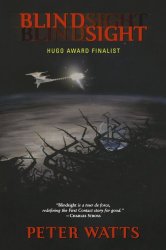
A derelict infinite probe hears whispers from a distant comet. Something talks out there: but not to u.s.. Who should we send to see the alien, when the conflicting doesn't desire to meet?
Send a linguist with multiple-personality disorder and a biologist so spliced with machinery that he can't feel his own mankind. Transport a pacifist warrior and a vampire recalled from the grave by the voodoo of paleogenetics. Send a human with half his mind gone since childhood. Send them to the edge of the solar system, praying you can trust such freaks and monsters with the fate of a globe. You fearfulness they may be more conflicting than the thing they've been sent to detect—only you'd requite anything for that to exist true, if you knew what was waiting for them. . . .
5

Both Brave New Earth and 1984 saw dystopian futures, just Huxley seems to accept gotten much of information technology right (though Orwell did boom the surveillance land). According to social critic Neil Postman:
"What Orwell feared were those who would ban books. What Huxley feared was that there would be no reason to ban a book, for there would be no ane who wanted to read one. Orwell feared those who would deprive us of information. Huxley feared those who would give us and then much that we would be reduced to passivity and egotism… Orwell feared we would get a captive culture. Huxley feared we would go a trivial culture, preoccupied with some equivalent of the feelies, the orgy porgy, and the centrifugal bumblepuppy."
6

It looks like a good deal at first: a peaceful alien invasion by the mysterious Overlords, whose inflow ends all state of war, helps class a world regime, and turns the planet into a near-utopia. Yet, they reject to answer questions near themselves and govern from orbiting spaceships.Clarke has said that the idea for Childhood'southward End may have come from the numerous blimps floating over London during World War Ii.
seven
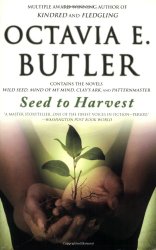
Seed to Harvest contains Octavia E. Butler's four acclaimed Patternmaster novels: Wild Seed, Mind of My Mind, Clay'southward Ark, and Patternmaster.
In ancient Africa, a female demigod of nurture and fertility mates with a powerful, destructive male person entity. Together they nascence a race of madmen, visionaries, and psychics who cling to civilization'south margins and back alleys for millennia, coming together in a telepathic Design only every bit Earth is consumed by a cosmic invasion. At present these new beings—no longer but human—will battle to rule the transfigured world.
viii

Attack the desert planet Arrakis, Dune is the story of the boy Paul Atreides, who would become the mysterious homo known equally Muad'Dib. He would avenge the traitorous plot confronting his noble family and bring to fruition humankind'southward near ancient and unattainable dream.
Dune is the world'southward best-selling science fiction novel of all time, and often described as The Lord of the Rings of science fiction. If you've never read a science fiction book before, don't kickoff here, but make it your fifth.
Did you know Dune was inspired past a trip to Oregon?
ix

Psychohistory is 1 of Asimov'southward best inventions: using a combination of history, psychology, and statistics, one tin can accurately predict the behavior of big groups of people.
Foundation covers the offset of the Galactic Empire's plummet, and one man'southward plan to reignite civilization after years of barbarism.
Asimov'south characters tend be one-dimensional, just his stories are so entertaining that it's like shooting fish in a barrel to forgive that lapse.
x

Narrated by a ghost that watches over the meg-twelvemonth evolution of the last group of humans on the planet, Galápagos questions the merit of the human being brain from an evolutionary perspective.
Some critics consider it one of Vonnegut's worst novels, but I strongly disagree. It'south funny, clever, and asks questions most post-apocalyptic books skip.
11

Few science fiction books can claim to utilize the aforementioned structure equally The Canterbury Tales and nevertheless exist kick-ass sci-fi, just Hyperion pulls it off.
On the world chosen Hyperion, across the police force of the Hegemony of Man, in that location waits the creature chosen the Shrike. There are those who worship it. There are those who fear it. And there are those who accept vowed to destroy it. In the Valley of the Time Tombs, where huge, brooding structures move backward through time, the Shrike waits for them all. On the eve of Armageddon, with the entire galaxy at war, vii pilgrims set forth on a final voyage to Hyperion seeking the answers to the unsolved riddles of their lives. Each carries a desperate promise—and a terrible secret. And ane may hold the fate of humanity in his hands.
12
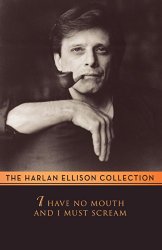
Pissing off science fiction writers everywhere, Ellison wrote the story "I Have No Mouth, and I Must Scream" in a single night in 1966, making virtually no changes from the first draft. He won a Hugo honor for it, too. Bounder.
thirteen

This is hard SF—lots of science and what ane reviewer chosen "mind processed," but not much character development.
The year is 2010. More than a century of ecological damage, industrial and technological expansion, and unchecked population growth accept left the Earth on the brink of devastation. Equally the globe'due south governments plow inward, i man dares to envision a bolder, brighter future. That man, Reid Malenfant, has a very different solution to the bug plaguing the planet: the exploration and colonization of space. Now Malenfant gambles the very existence of time on a single desperate throw of the dice. Battling national sabotage and international outcry, every bit apocalyptic riots sweep the globe, he builds a spacecraft and launches it into deep space. The odds are a trillion to 1 confronting him. Or are they?
xiv

The twelvemonth is Advert 7000. The human being species is virtually extinct—for the fourth fourth dimension—due to its delicate nature.
Krina Alizond-114 is metahuman, descended from the robots that one time served humanity. She'due south on a journey to the h2o world of Shin-Tethys to find her sister Ana. Just her trip is interrupted when pirates capture her transport. Their leader, the enigmatic Count Rudi, believes that there'due south more to Krina's search than meets the eye.
He'due south correct: Krina and Ana each possess half of the fabled Atlantis Carnet, a lost financial musical instrument of unbelievable value—capable of bringing downward entire civilizations. Krina doesn't know that Count Rudi suspects her motives, so she accepts his offer to get her to Shin-Tethys in exchange for an introduction to Ana.
And what neither of them suspects is that a ruthless body-double assassinator has stalked Krina across the galaxy, prepare to take the carnet once it is whole—and go out no witnesses alive to tell the tale…
As ever, Stross feels like the smartest guy in the room, pushing the boundaries of identity and humanity while offering upwards what may exist the first epic tale of futuristic macroeconomics.
—Publishers Weekly
15

Given that the suns of Draco stretch almost sixteen calorie-free years from terminate to end, it stands to reason that the cost of transportation is the nigh important factor of the 32nd century. And since Illyrion is the chemical element most needed for space travel, Lorq von Ray is plenty willing to fly through the cadre of a recently imploded lord's day in guild to obtain vii tons of information technology. The potential for profit is then great that Lorq has little difficulty cobbling together an alluring coiffure that includes a gypsy musician and a moon-obsessed scholar interested in the ancient art of writing a novel. What the coiffure doesn't know, though, is that Lorq's quest is actually fueled by a private revenge so consuming that he'll end at nothing to accomplish information technology.
16

The good news is that humanity finally made it into interstellar space. The bad news is that planets that are fit to alive on are scarce—and alien races willing to fight usa for them are common. So nosotros fight, both to defend Earth, and to pale our own claim to planetary real estate. Far from Earth, the war has been going on for decades: savage, encarmine, and unyielding.
Earth itself is a backwater. The bulk of humanity's resources are in the hands of the Colonial Defense force Strength. Everybody knows that when you achieve retirement age, you tin can join the CDF. They don't want young people; they desire people who acquit the knowledge and skills of decades of living. Yous'll be taken off Globe and never allowed to return. Y'all'll serve 2 years at the forepart. And if yous survive, y'all'll exist given a generous homestead stake of your own, on ane of our hard-won colony planets.
On his 75th altogether John Perry did two things: Start he visited his married woman's grave. Then he joined the CDF. He has merely the vaguest idea what to expect, because the actual fight, light-years from dwelling, is far, far harder than he can imagine—and what he will become is far stranger.
17
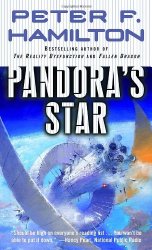
The human being race has had wormhole engineering science for over 300 years and has colonized several hundred planets.
Over one thousand light-years abroad, a star . . . vanishes. It does not get supernova. It does non plummet into a black hole. It simply disappears. Since the location is likewise distant to reach by wormhole, a faster-than-light starship, the 2d Chance, is dispatched to larn what has occurred and whether it represents a threat. In command is Wilson Kime, a five-time rejuvenated ex-NASA pilot whose celebrity days are centuries backside him.
Hamilton'south exhilarating new opus proves that "intelligent space opera" isn't an oxymoron.
– Publisher'south Weekly
eighteen

Iain M. Banks is my 2nd-favorite SF author (afterwards Stanislaw Lem), and The Player of Games was my first Banks book, and so I'm ever happy to recommend it.
The Culture – a man/machine symbiotic lodge – has thrown upwardly many dandy Game Players, and one of the greatest is Gurgeh. Jernau Morat Gurgeh. The Thespian of Games. Master of every board, reckoner and strategy. Bored with success, Gurgeh travels to the cruel and incredibly wealthy Empire of Azad, to try their fabulous game…a game and so circuitous, so like life itself, that the winner becomes emperor. Mocked, blackmailed, almost murdered, Gurgeh accepts the game, and with it the challenge of his life—and very peradventure his death.
19
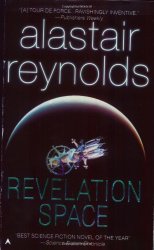
Alastair Reynolds's showtime novel is "difficult" SF on an epic calibration, crammed with technological marvels and immensities.
I man probes a galaxy-wide enigma: why does space-faring humanity encounter and then few remnants of intelligent life?
"Reynolds'south vision of a future dominated by artificial intelligence trembles with the ultimate cold of the night between the stars."
-Publishers Weekly
twenty

Ringworld is considered a science fiction classic, and it won the Hugo, Nebula, and Locus awards while spawning three sequels and four prequels.
An expedition'due south goal is to explore a ringworld: an artificial ring about 1 million miles wide and approximately the diameter of Earth'south orbit (which makes it well-nigh 600 1000000 miles in circumference), encircling a sunlike star. It rotates, providing bogus gravity that is 99.ii% as potent as Earth'south gravity through the action of centrifugal force. The ringworld has a habitable, flat inner surface equivalent in area to approximately three meg World-sized planets. Night is provided by an inner band of shadow squares which are continued to each other by thin, ultra-strong wire.
21

Another classic on this list, Tales of the Dying Globe is an omnibus volume comprising all 4 books in the dying Earth series: The Dying Earth, The Optics of the Overworld, Cugel'due south Saga, and Rialto the Magnificent.
A fascinating, bizarre tale set on a far-futurity Earth, nether a behemothic blood-red sunday that is soon to go out forever. Annotation that these books are also classified as fantasy.
22

Le Guin's won the Hugo Honour, Nebula Accolade, Locus Award, and World Fantasy Award, each more than than once, but she wasn't ever successful. From 1951 to 1961 she wrote 5 novels, which publishers rejected because they seemed inaccessible (The Dispossessed isn't one of those v).
Shevek, a vivid physicist, decides to have action. He will seek answers, question the unquestionable, and attempt to tear downwards the walls of hatred that have isolated his planet of anarchists from the residuum of the civilized universe. To exercise this unsafe job will mean giving up his family and perchance his life. Shevek must make the unprecedented journey to the utopian female parent planet, Anarres, to claiming the complex structures of life and living, and ignite the fires of change.
23

Jean le Flambeur gets up in the morning and has to kill himself before his other self can kill him kickoff. Just another day in the Dilemma Prison house. Rescued by the mysterious Mieli and her flirtatious spacecraft, Jean is taken to the Oubliette, the Moving City of Mars, where time is a currency, memories are treasures, and a moon-turned-singularity lights the dark. Meanwhile, investigator Isidore Beautrelet, called in to investigate the murder of a chocolatier, finds himself on the trail of an arch-criminal, a man named le Flambeur….
Indeed, in his many lives, the entity called Jean le Flambeur has been a thief, a confidence creative person, a posthuman mind-burglar, and more. His origins are shrouded in mystery, just his deeds are known throughout the Heterarchy—from breaking into the vast Zeusbrains of the Inner System to stealing rare Globe antiques from the aristocrats of Mars. In his last exploit, he managed the supreme feat of hiding the truth about himself from the one person in the solar system hardest to hibernate from: himself. Now he has the risk to regain himself in all his power—in commutation for finishing the one heist he never quite managed.
24

A great old classic that invented the phrase "time car."
But don't watch the modern picture show, because that ends in a fistfight for some reason.
25

Anderson Lake is a company homo, AgriGen'due south Calorie Homo in Thailand. Surreptitious as a factory manager, Anderson combs Bangkok's street markets in search of foodstuffs thought to be extinct, hoping to reap the compensation of history's lost calories. In that location, he encounters Emiko. Emiko is the Windup Daughter, a foreign and beautiful creature. One of the New People, Emiko is not human; instead, she is an engineered existence, creche-grown and programmed to satisfy the corrupt whims of a Kyoto businessman, merely at present abandoned to the streets of Bangkok. Regarded as soulless beings by some, devils past others, New People are slaves, soldiers, and toys of the rich in a chilling almost future in which calorie companies dominion the globe, the oil age has passed, and the side effects of bio-engineered plagues run rampant across the globe.
Reddit Speaks
I linked to this post from reddit, and got some excellent suggestions (some more polite than others) almost books that should have been on this list:
Source: https://best-sci-fi-books.com/25-best-far-future-science-fiction-books/
0 Response to "70s Sci Fi Art Book About Living in the Future"
Post a Comment